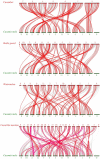Genome-Wide Identification and Characterization of Melon bHLH Transcription Factors in Regulation of Fruit Development
- PMID: 34961193
- PMCID: PMC8709311
- DOI: 10.3390/plants10122721
Genome-Wide Identification and Characterization of Melon bHLH Transcription Factors in Regulation of Fruit Development
Abstract
The basic helix-loop-helix (bHLH) transcription factor family is one of the largest transcription factor families in plants and plays crucial roles in plant development. Melon is an important horticultural plant as well as an attractive model plant for studying fruit ripening. However, the bHLH gene family of melon has not yet been identified, and its functions in fruit growth and ripening are seldom researched. In this study, 118 bHLH genes were identified in the melon genome. These CmbHLH genes were unevenly distributed on chromosomes 1 to 12, and five CmbHLHs were tandem repeat on chromosomes 4 and 8. There were 13 intron distribution patterns among the CmbHLH genes. Phylogenetic analysis illustrated that these CmbHLHs could be classified into 16 subfamilies. Expression patterns of the CmbHLH genes were studied using transcriptome data. Tissue specific expression of the CmbHLH32 gene was analysed by quantitative RT-PCR. The results showed that the CmbHLH32 gene was highly expressed in female flower and early developmental stage fruit. Transgenic melon lines overexpressing CmbHLH32 were generated, and overexpression of CmbHLH32 resulted in early fruit ripening compared to wild type. The CmbHLH transcription factor family was identified and analysed for the first time in melon, and overexpression of CmbHLH32 affected the ripening time of melon fruit. These findings laid a foundation for further study on the role of bHLH family members in the growth and development of melon.
Keywords: CmbHLH32; bHLH; fruit ripening; melon.
Conflict of interest statement
The research was conducted in the absence of any potential conflicts of interest.
Figures








Similar articles
-
Genome-wide identification, evolution and expression profiles analysis of bHLH gene family in Castanea mollissima.Front Genet. 2023 May 12;14:1193953. doi: 10.3389/fgene.2023.1193953. eCollection 2023. Front Genet. 2023. PMID: 37252667 Free PMC article.
-
Genome-wide analysis of basic helix-loop-helix superfamily members in peach.PLoS One. 2018 Apr 16;13(4):e0195974. doi: 10.1371/journal.pone.0195974. eCollection 2018. PLoS One. 2018. PMID: 29659634 Free PMC article.
-
Identification of CmbHLH Transcription Factor Family and Excavation of CmbHLHs Resistant to Necrotrophic Fungus Alternaria in Chrysanthemum.Genes (Basel). 2023 Jan 20;14(2):275. doi: 10.3390/genes14020275. Genes (Basel). 2023. PMID: 36833202 Free PMC article.
-
Genome-wide identification of microRNAs involved in the regulation of fruit ripening and climacteric stages in melon (Cucumis melo).Hortic Res. 2020 Jul 1;7:106. doi: 10.1038/s41438-020-0331-3. eCollection 2020. Hortic Res. 2020. PMID: 32637134 Free PMC article.
-
Basic Helix-Loop-Helix (bHLH) Transcription Factors Regulate a Wide Range of Functions in Arabidopsis.Int J Mol Sci. 2021 Jul 1;22(13):7152. doi: 10.3390/ijms22137152. Int J Mol Sci. 2021. PMID: 34281206 Free PMC article. Review.
Cited by
-
Drought stress tolerance mechanisms and their potential common indicators to salinity, insights from the wild watermelon (Citrullus lanatus): A review.Front Plant Sci. 2023 Feb 6;13:1074395. doi: 10.3389/fpls.2022.1074395. eCollection 2022. Front Plant Sci. 2023. PMID: 36815012 Free PMC article. Review.
-
Genome-wide characterization of the bHLH gene family in Gynostemma pentaphyllum reveals its potential role in the regulation of gypenoside biosynthesis.BMC Plant Biol. 2024 Mar 20;24(1):205. doi: 10.1186/s12870-024-04879-y. BMC Plant Biol. 2024. PMID: 38509465 Free PMC article.
-
Comprehensive analysis of transcriptome and metabolome identified the key gene networks regulating fruit length in melon.BMC Plant Biol. 2025 Apr 8;25(1):442. doi: 10.1186/s12870-025-06332-0. BMC Plant Biol. 2025. PMID: 40200143 Free PMC article.
-
Genome-Wide Identification of the bHLH Gene Family in Magnolia sieboldii and Response of MsPIFs to Different Light Qualities.Int J Mol Sci. 2025 Mar 28;26(7):3152. doi: 10.3390/ijms26073152. Int J Mol Sci. 2025. PMID: 40243898 Free PMC article.
-
The Key Metabolic Network and Genes Regulating the Fresh Fruit Texture of Jujube (Ziziphus jujuba Mill.) Revealed via Metabolomic and Transcriptomic Analysis.Plants (Basel). 2023 May 24;12(11):2087. doi: 10.3390/plants12112087. Plants (Basel). 2023. PMID: 37299066 Free PMC article.
References
LinkOut - more resources
Full Text Sources

